2005 年 11 月翻译资格考试三级英语笔译实务真题及答案
试题部分:
Section 1: English-Chinese Translation (英译汉) Translate the following passage
into Chinese.
The Gap between Rich and Poor Widened in U.S. Capital
Washington D.C. ranks first among the 40 cities with the widest gap between the poor
and the rich, according to a recent report released by the D.C. Fiscal Policy
Institute on July 22nd. The top 20 percent of households in D.C. have an average
yearly income of $186,830, 31 times that of the bottom 20 percent, which earns only
$6,126 per year. The income gap is also big in Atlanta and Miami, but the difference
is not as pronounced.
The report also indicates that the widening gap occurred mainly during the 1990s.
Over the last decade, the average income of the top 20 percent of households has
grown 36 percent, while the average income of the bottom 20 percent has only risen
3 percent.
"I believe the concentration of the middle- to high-income families in the D.C. area
will continue, therefore, the income gap between rich and poor will be hard to
bridge," David Garrison told the Washington Observer. Garrison is a senior
researcher with the Brookings Institution, specializing in the study of the social
and economic policies in the greater Washington D.C. area.
The report attributed the persistent income gap in Washington to the area's special
job opportunities, which attract high-income households. Especially since the
federal government is based in Washington D.C., Government agencies and other
government related businesses such as lobbying firms and government contractors
constantly offer high-paying jobs, which contribute to the trend of increasing
high-income households in the D.C. area. For example, a single young professional
working in a law firm in D.C. can earn as much as $100,000 in his or her first year
out of law school.
"In addition, high-quality housing available in Washington D.C. is one of the main
reasons why high-income families choose to live here, while middle and low-income
families, if they can afford it, choose to move out of Washington D.C. to the Virginia
and Maryland suburbs so that their kids can go to better schools," stated Garrison.
"As rich families continue to move into D.C. and middle and low-income families are
moving out, the poorest families are left with nowhere to move, or cannot afford
to move. This creates the situation we face now: a huge income gap between the rich
�
and poor."
The Washington D.C. area to which Garrison refers is the District of Columbia city
itself, not including the greater Washington metro area. "The greater Washington
metro area has a large population of about 5 million, but the low-income households
are often concentrated in D.C. proper," Garrison explained.
Tony Blalock, the spokesperson for Mayor Anthony Williams, said resignedly, "No
matter what we seem to do to bring investment into the District, a certain population
is not able to access the unique employment opportunities there. The gap between
the rich and
poor is the product of complex forces, and won't be fixed overnight."
Garrison believes that the D.C. government should attract high-income families. By
doing so, the District's tax base can grow, which in turn can help improve D.C.'s
infrastructure. "But in the meantime, the District government should also take into
consideration the rights of the poor, set up good schools for them, and provide sound
social welfare. All these measures can alleviate the dire situation caused by income
disparity. "
Garrison, however, is not optimistic about the possibility of closing the gap between
the rich and poor. He is particularly doubtful that current economic progress will
be able to help out the poor. "Bush's tax-cut plan did bring about this wave of
economic recovery, and the working professionals and rich did benefit from it. It
is unfair to say that the plan did not
help the poor at all… it just didn't benefit
them as much as it did the rich, " Garrison said. "The working class in America,
those who do the simplest work, get paid the least, and dutifully pay their taxes,
has not benefited from Bush's tax-cut plan much."
Garrison concludes, "A lot of cities in America did not enjoy the positive impact
of the economic recovery. Washington D.C., on the other hand, has always been
sheltered by the federal government. The wide gap between rich and poor in the
District, therefore, deserves more in-depth study and exploration."
Section 2: Chinese-English Translation (汉译英) Translate the following passage
into English.
25 年来,中国坚定不移地推进改革开放,社会主义市场经济体制初步建立,开放型经济已
经形成,社会生产力和综合国力不断增强,各项社会事业全面发展,人民生活总体上实现了
由温饱到小康的历史性跨越。从 1978 年至 2003 年的 25 年间,中国经
济年均增长 9.4 。25 年前,中国年国内生产总值为 1473 亿美元,去年已达到 14000
多亿美元。25 年前,中国年进出口贸易总额为 206 亿美元,去年已达到 8512 亿美元。
�
25 年前,中国外汇储备为 1.67 亿美元,去年已达到 4033 亿美元。目前,中国经济总量
居世界第六,进出口贸易总额居世界第四。中国之所以能够发生这样巨大的变化, 最关键
的原因是我们始终坚持走中国特色社会主义道路,始终坚持改革开放,激发了全体人民的积
极性、主动性、创造性。
中国虽然取得了很大的发展成就,但中国人口多,底子薄,生产力不发达,发展很不平衡,
生态环境、自然资源与经济社会发展的矛盾比较突出。虽然中国人均国内生产总值已经突破
1000 美元,但仍排在世界一百位以后。中国要实现现代化,使全体人民都过上富裕生活,
还需要进行长期不懈的艰苦奋斗。
我们已经明确了本世纪头 20 年的奋斗目标,这就是全面建设惠及十几亿人口的更
高水平的小康社会,到 2020 年实现国内生产总值比 2000 年翻两番,达到 4 万亿美元,
人均国内生产总值达到 3000 美元,使经济更加发展、民主更加健全、科教更加进步、文化
更加繁荣、社会更加和谐、人民生活更加殷实。
答 案 部 分 : Section 1: 英译汉参考译文
美国首都贫富不均情况加重
美国首都独立研究机构华盛顿特区财政政策研究院(DC Fiscal Policy Institute)于
7 月 22 日公布的一份其最新的研究报告显示,华盛顿特区的贫富差距居全美 40 个大都会
区之冠,20 最富有的家庭其年收入高达$186,830 美元,是 20 最贫穷家庭年收入(仅$6,126
美元)的 31 倍。虽然亚大兰大和迈阿密两市的贫富差距与华盛顿相当,但其贫富不均的情
况却不如华盛顿明显。
报告指出,华盛顿特区贫富差距逐渐加大主要是发生在 90 年代。在过去十年中,20 最富
有的家庭其年收入增长了 36 倍,而 20 最贫穷家庭的年收入仅仅增加了 3 倍。
“我认为中高收入家庭过分集中在特区的情况仍然会持续下去,在未来十年内贫富鸿沟恐怕
难以拉近,”布鲁金斯学院(Brookigns Institution)专攻大华盛顿地区经济和社会形势的
高级研究员大卫•盖立森(Daivd Garrison)对《华盛顿观察》周刊说道。
这份报告将华盛顿特区的贫富鸿沟归咎于当地特殊的工作机会。而这些工作往往会吸引高收
入家庭搬到此地。特别是华盛顿也是美国联邦政府的所在地,而联邦政府和与政府相关的行
业,如院外游说团体和政府合约承包商等等,不断提供高薪工作,也使得华府的高收入家庭
有不断增加的趋势。举例来说,一个单身的年轻专业人士从法学院毕业后,在华府的律师事
务所服务第一年的年收入可高达$100,000 美元。
“此外,华盛顿特区也提供高品质的住宅(high-quality housing),这也是为什么高薪家
庭选择在华府居住的主因之一,”盖立森分析道,“而一般中低收入家庭,在有余力的情况下,
为了孩子能够上较好的学校而选择搬离华盛顿特区,移至分布于马里兰州和弗吉尼亚州的住
�
“在高收入家庭不
宅区。”
断迁移到特区、中低阶层的家庭移出,而最贫穷的家庭又面临无处,也无力可搬的窘境时,
就造成我们现在看到的,贫富悬殊的华盛顿特区,”盖立森对《华盛顿观察》周刊说到。
盖立森此处所指的华盛顿特区指的是约有 56 万人口的都市(District of Columbia)本身,
不包括整个华盛顿大都会区(Greater Washington Metro Area),“整个华盛顿大都会区人
口高达 500 万人,但低收入户却只往华盛顿特区集中,”他特别解释道。
“不论我们如何努力吸引商家到华盛顿特区投资,华府有一部分的低收入家庭就是无法从中
受惠,没有办法得到特区独特的高薪工作机会。”华盛顿市长办公室发言人托尼•布拉克(Tony
Bullock)说,“贫富差距的背后许多复杂的原因,是不能在一夕之间就改变的。”他言谈间
颇有对特区的贫富悬殊无可奈何之叹。
盖立森则认为,特区政府的确应该吸引高收入家庭到特区居住,因为这样能够带来更多税收,
对市政建设有积极作用。“但同时,特区政府也应该重视穷人的权益,设立好的学校、提供
健全的社会福利等等,这些市政措施都能有效地改善特区严重的贫富不均状况。”
但盖立森对未来贫富差距是否真能拉近不是十分乐观,他尤其对这波经济复苏是不是能 帮
助到穷人保持怀疑的态度:“布什的减税方案虽然带动了美国这波经济复苏,有工作的 人
和富人的确享受到不少好处,但对穷人的帮助虽然不能说是完全没有,也只能说是不如 富
人的获益高,”盖立森分析道,“美国一般的工薪族(working class),也就是那些做初级工
作、拿最低工资、老老实实缴税的人,实在没有从布什的减税案得到太大益处。” 盖立森
总结说:“美国许多城市并没有享受到美国经济好转所带来的积极价值,但华盛 顿特区一
直以来受到联邦政府的庇佑,它贫富悬殊的情况仍然如此严重,确实值得深入的研究和检
讨。”
Section 2: 汉译英
参考译文
Over the past 25 years, China has been firmly pressing ahead with the implementation
of the reform program and the initiative of opening up to the outside world. With
the establishment of a preliminary socialist market economy, and the nation’s
economy attaining an outward-oriented perspective, the productive
forces and the
comprehensive national competence have been on the rising curve constantly. And
various social undertakings have been developing in full swing. The living standard
of the Chinese people as a whole has undergone a historical leap from a subsistence
level to the level of moderate prosperity.
In the 25 years between 1978 and 2003, the annual growth rate of China's economy
was running at an average of 9.4 percent, with its GDP jumping from 147.3 billion
US dollars to over 1.4 trillion US dollars.
25 years ago, China’s foreign trade value and foreign exchange reserves each stood
�
at 20.6 billion and 167 million in US dollars, but last year they shot up to 851.2
billion US dollars and 403.3 billion US dollars respectively. China has now become
the sixth largest economy and the fourth largest trader in the world.
The tremendous changes in China are attributed to the fact that we have adhered to
the path of building socialism with Chinese characteristics and persevered in our
reform and opening endeavors, which brought into full play the Chinese people's
initiative, enthusiasm and creativeness.
Though China has scored impressive achievements in its development, we must not lose
sight of our problems: overpopulation, a weak economic foundation, underdeveloped
productivity, highly uneven development, and the fairly sharp contradictions
between the country's ecological environment and natural resources
on the one hand
and its economic and social development on the other.
China's per capita GDP, though reaching the record high of 1,000 US dollars last
year, still ranks well behind the 100th place in the world. To realize China's
modernization program and offer all the Chinese people a prosperous life there is
yet an uphill battle to fight.
We have already set our vision for the first 20 years of this century, which involves
the building of a moderately prosperous society of a higher standard in an all-round
way for the benefit of well over one billion Chinese people. By 2020 the GDP will
be quadrupled from the figure of 2000 to 4 trillion US dollars, with the per capita
level averaging at 3,000 US dollars. By then the nation will be immersed in an
ambience of greater social harmony with an improved quality of life for the people,
featuring a more developed economy, more sound democracy, more thriving culture and
more advanced science and education.
�
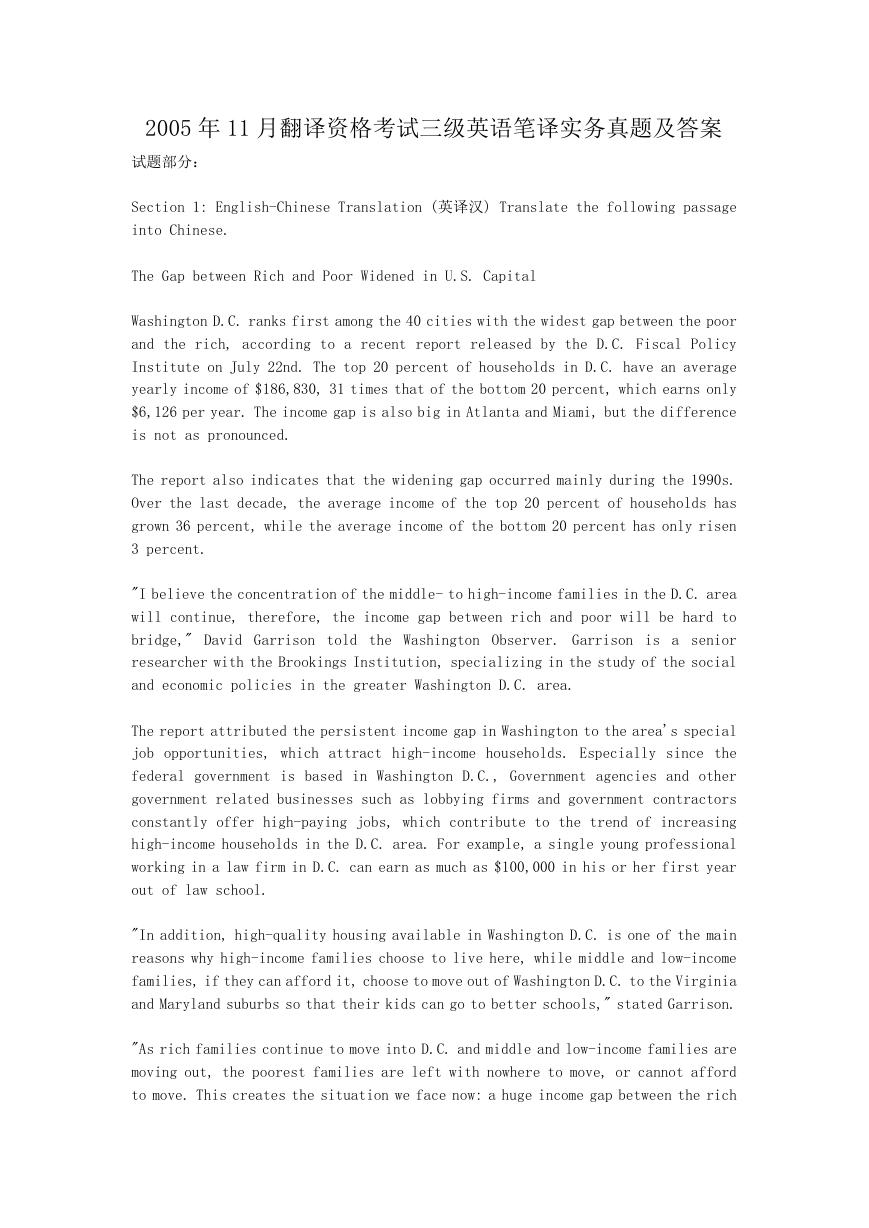
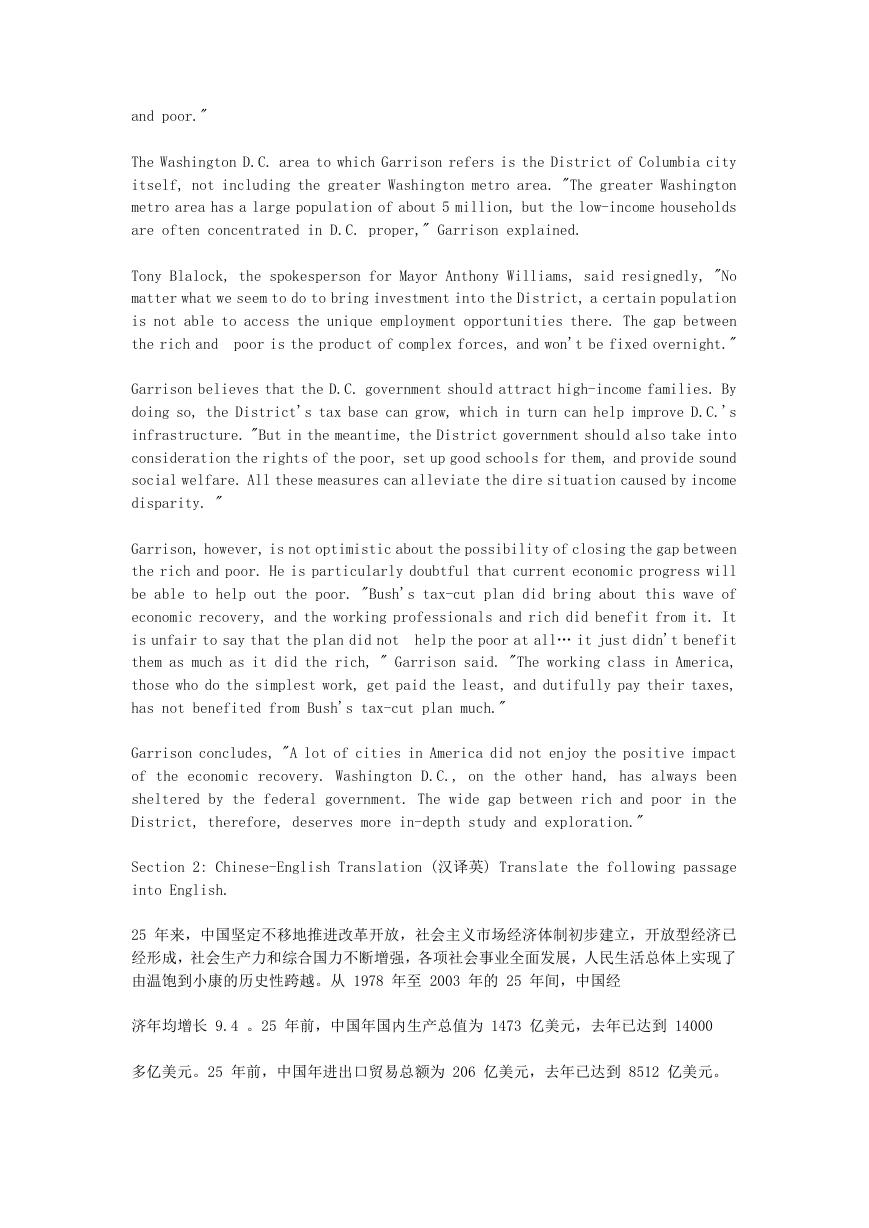
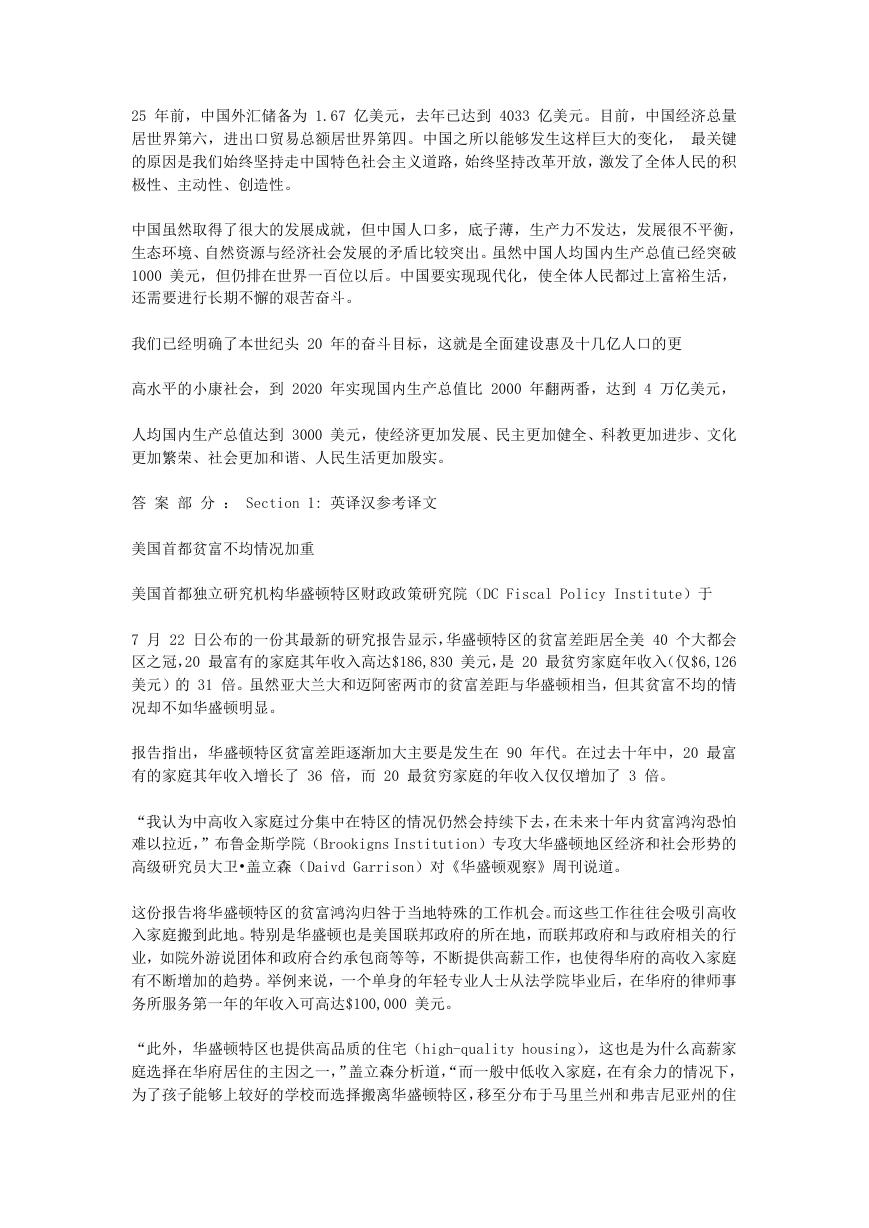
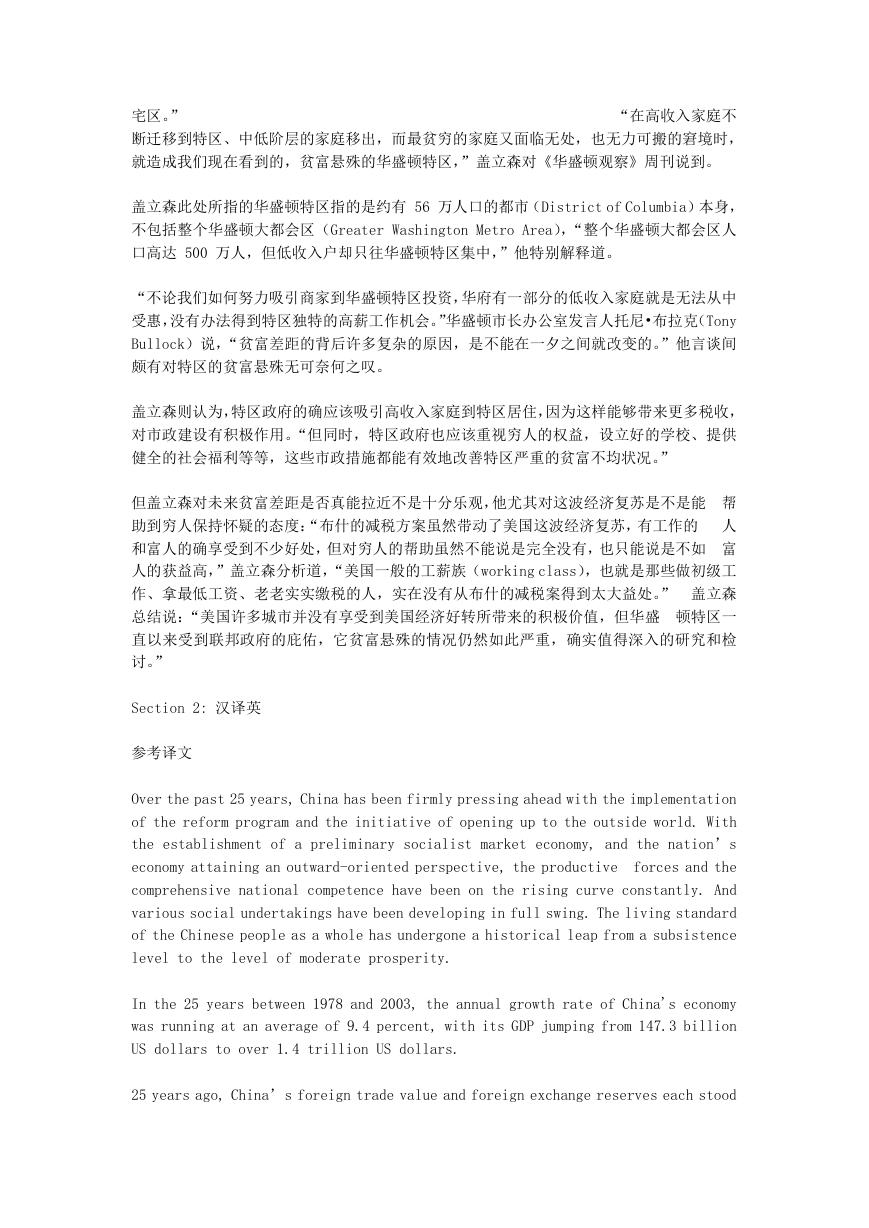
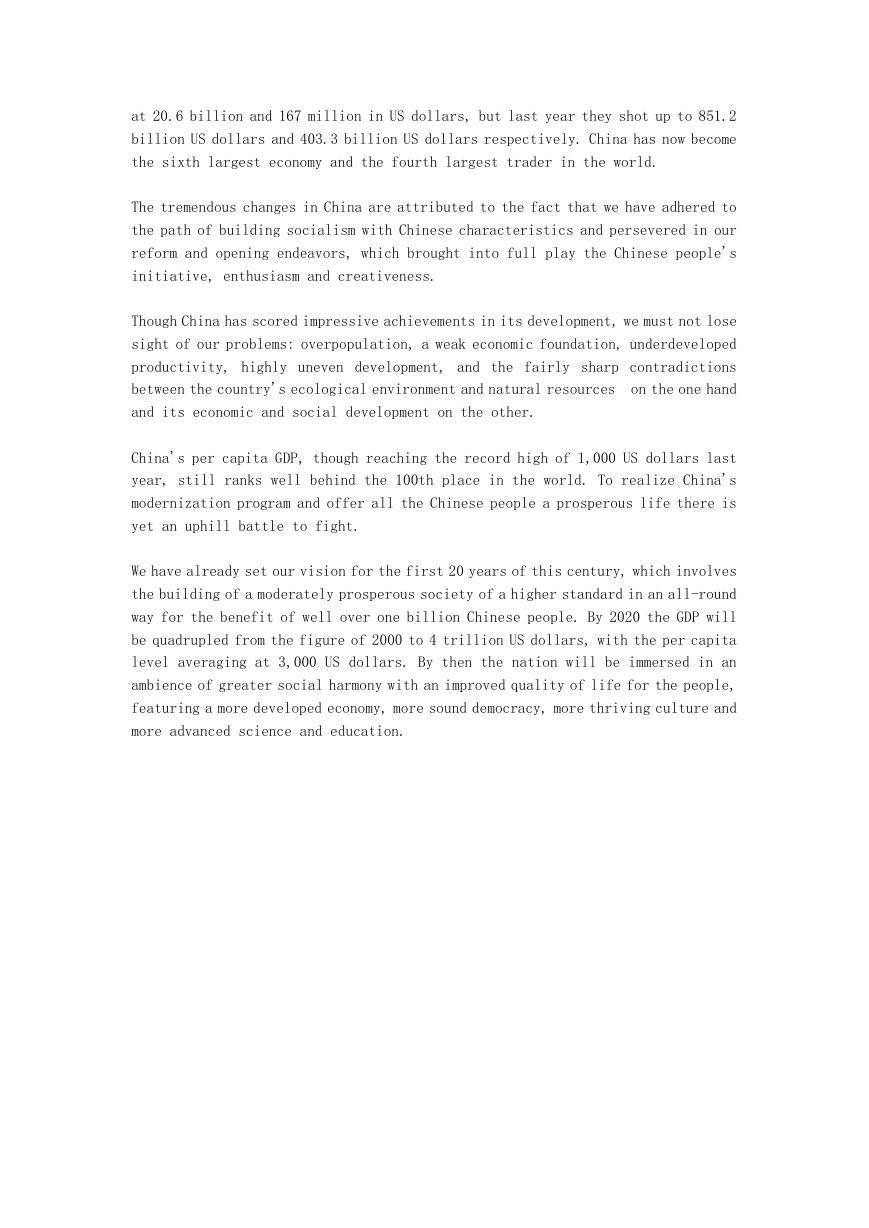





 2023年江西萍乡中考道德与法治真题及答案.doc
2023年江西萍乡中考道德与法治真题及答案.doc 2012年重庆南川中考生物真题及答案.doc
2012年重庆南川中考生物真题及答案.doc 2013年江西师范大学地理学综合及文艺理论基础考研真题.doc
2013年江西师范大学地理学综合及文艺理论基础考研真题.doc 2020年四川甘孜小升初语文真题及答案I卷.doc
2020年四川甘孜小升初语文真题及答案I卷.doc 2020年注册岩土工程师专业基础考试真题及答案.doc
2020年注册岩土工程师专业基础考试真题及答案.doc 2023-2024学年福建省厦门市九年级上学期数学月考试题及答案.doc
2023-2024学年福建省厦门市九年级上学期数学月考试题及答案.doc 2021-2022学年辽宁省沈阳市大东区九年级上学期语文期末试题及答案.doc
2021-2022学年辽宁省沈阳市大东区九年级上学期语文期末试题及答案.doc 2022-2023学年北京东城区初三第一学期物理期末试卷及答案.doc
2022-2023学年北京东城区初三第一学期物理期末试卷及答案.doc 2018上半年江西教师资格初中地理学科知识与教学能力真题及答案.doc
2018上半年江西教师资格初中地理学科知识与教学能力真题及答案.doc 2012年河北国家公务员申论考试真题及答案-省级.doc
2012年河北国家公务员申论考试真题及答案-省级.doc 2020-2021学年江苏省扬州市江都区邵樊片九年级上学期数学第一次质量检测试题及答案.doc
2020-2021学年江苏省扬州市江都区邵樊片九年级上学期数学第一次质量检测试题及答案.doc 2022下半年黑龙江教师资格证中学综合素质真题及答案.doc
2022下半年黑龙江教师资格证中学综合素质真题及答案.doc